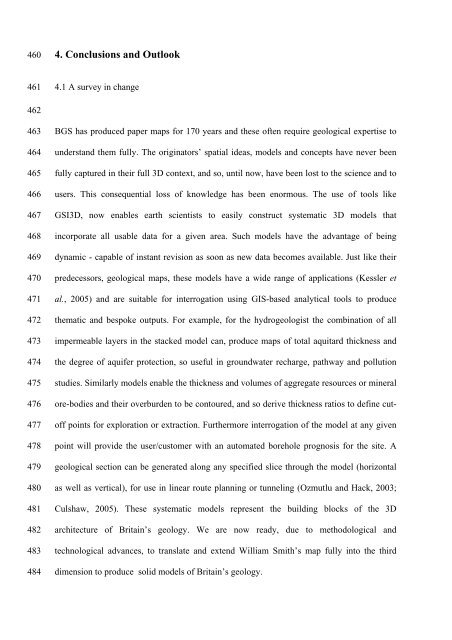The capture and dissemination of integrated 3D geospatial ...
The capture and dissemination of integrated 3D geospatial ...
The capture and dissemination of integrated 3D geospatial ...
Create successful ePaper yourself
Turn your PDF publications into a flip-book with our unique Google optimized e-Paper software.
460<br />
461<br />
462<br />
463<br />
464<br />
465<br />
466<br />
467<br />
468<br />
469<br />
470<br />
471<br />
472<br />
473<br />
474<br />
475<br />
476<br />
477<br />
478<br />
479<br />
480<br />
481<br />
482<br />
483<br />
484<br />
4. Conclusions <strong>and</strong> Outlook<br />
4.1 A survey in change<br />
BGS has produced paper maps for 170 years <strong>and</strong> these <strong>of</strong>ten require geological expertise to<br />
underst<strong>and</strong> them fully. <strong>The</strong> originators’ spatial ideas, models <strong>and</strong> concepts have never been<br />
fully <strong>capture</strong>d in their full <strong>3D</strong> context, <strong>and</strong> so, until now, have been lost to the science <strong>and</strong> to<br />
users. This consequential loss <strong>of</strong> knowledge has been enormous. <strong>The</strong> use <strong>of</strong> tools like<br />
GSI<strong>3D</strong>, now enables earth scientists to easily construct systematic <strong>3D</strong> models that<br />
incorporate all usable data for a given area. Such models have the advantage <strong>of</strong> being<br />
dynamic - capable <strong>of</strong> instant revision as soon as new data becomes available. Just like their<br />
predecessors, geological maps, these models have a wide range <strong>of</strong> applications (Kessler et<br />
al., 2005) <strong>and</strong> are suitable for interrogation using GIS-based analytical tools to produce<br />
thematic <strong>and</strong> bespoke outputs. For example, for the hydrogeologist the combination <strong>of</strong> all<br />
impermeable layers in the stacked model can, produce maps <strong>of</strong> total aquitard thickness <strong>and</strong><br />
the degree <strong>of</strong> aquifer protection, so useful in groundwater recharge, pathway <strong>and</strong> pollution<br />
studies. Similarly models enable the thickness <strong>and</strong> volumes <strong>of</strong> aggregate resources or mineral<br />
ore-bodies <strong>and</strong> their overburden to be contoured, <strong>and</strong> so derive thickness ratios to define cut-<br />
<strong>of</strong>f points for exploration or extraction. Furthermore interrogation <strong>of</strong> the model at any given<br />
point will provide the user/customer with an automated borehole prognosis for the site. A<br />
geological section can be generated along any specified slice through the model (horizontal<br />
as well as vertical), for use in linear route planning or tunneling (Ozmutlu <strong>and</strong> Hack, 2003;<br />
Culshaw, 2005). <strong>The</strong>se systematic models represent the building blocks <strong>of</strong> the <strong>3D</strong><br />
architecture <strong>of</strong> Britain’s geology. We are now ready, due to methodological <strong>and</strong><br />
technological advances, to translate <strong>and</strong> extend William Smith’s map fully into the third<br />
dimension to produce solid models <strong>of</strong> Britain’s geology.

















